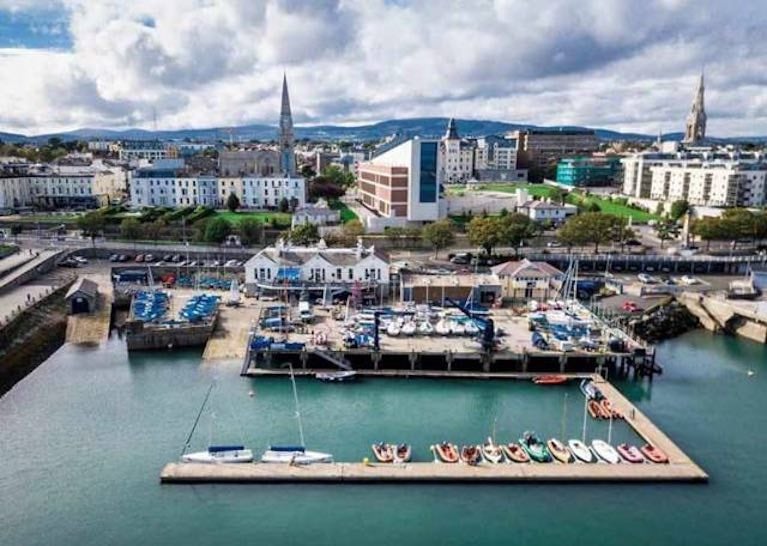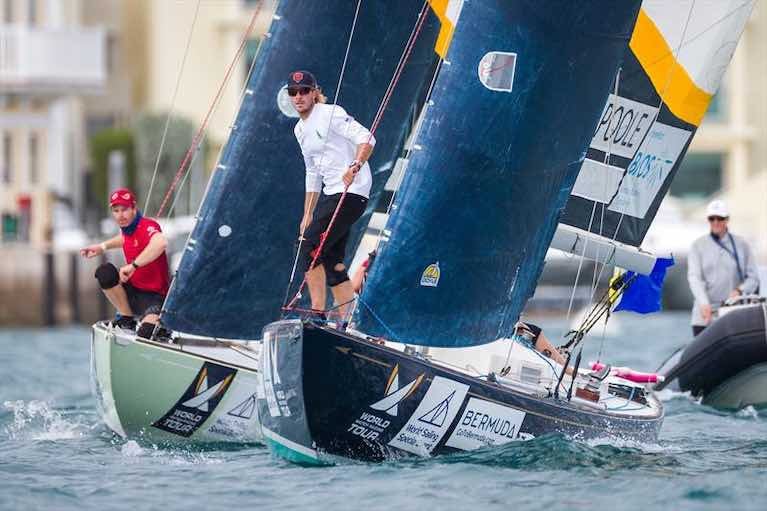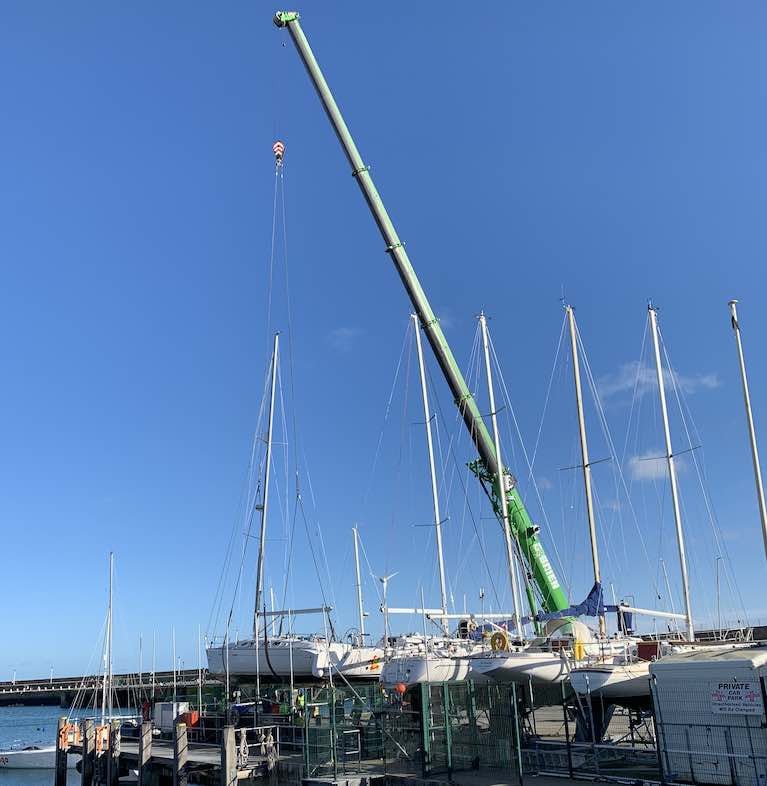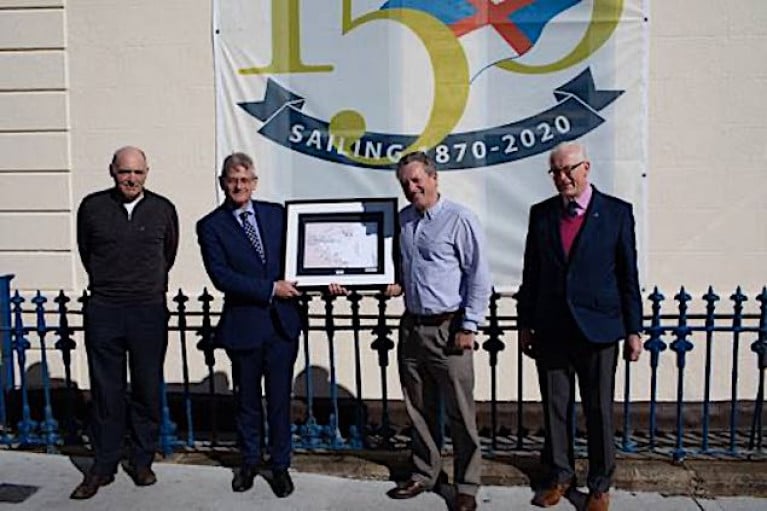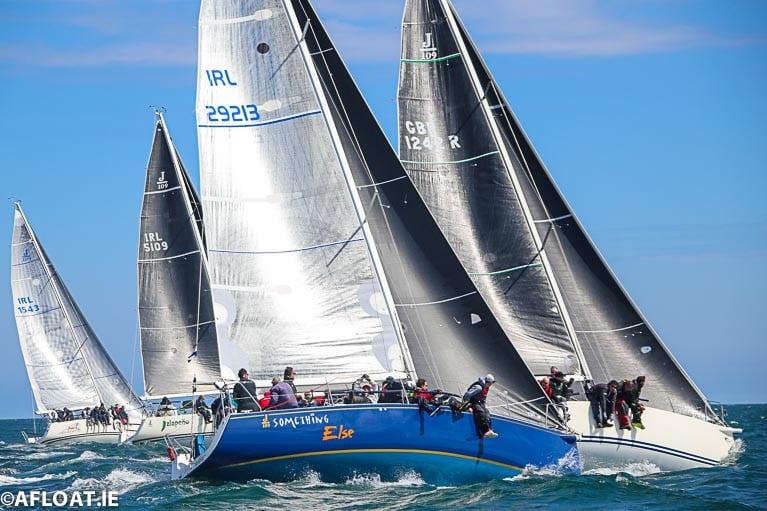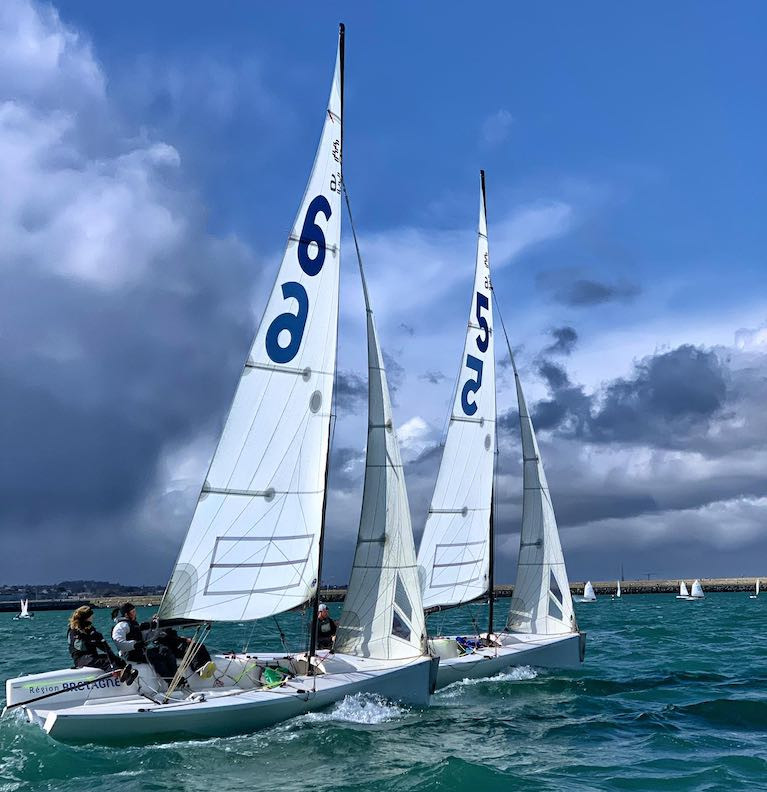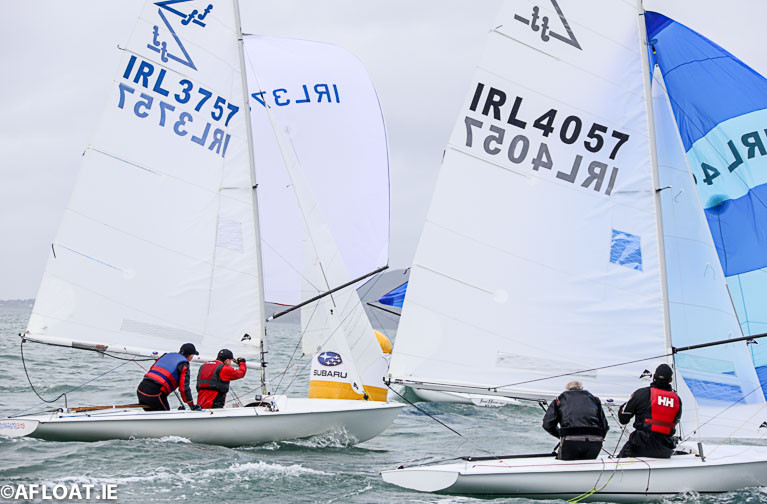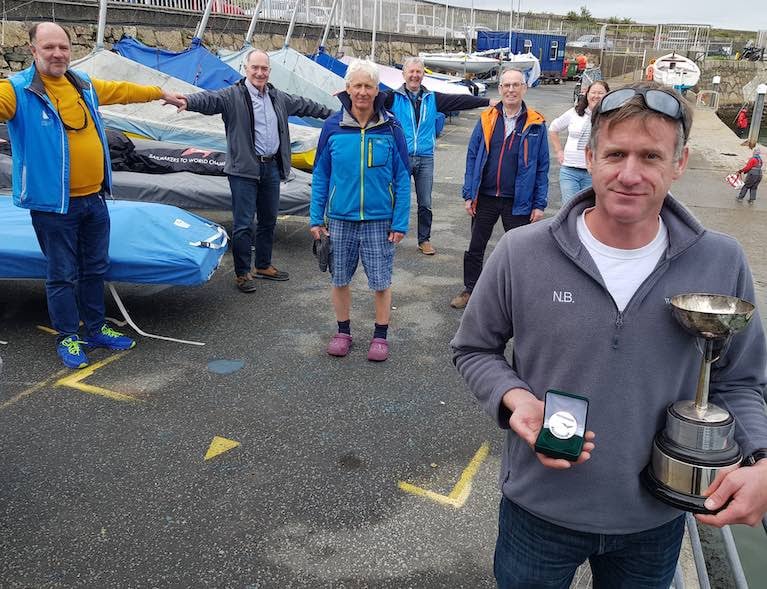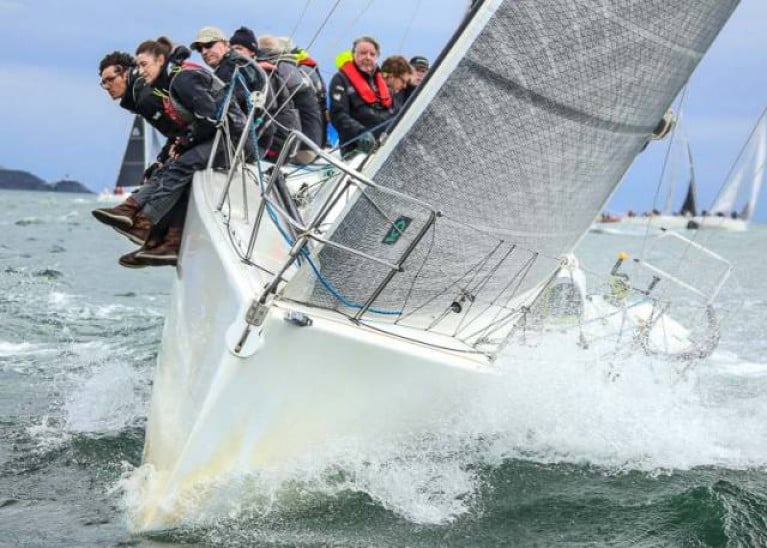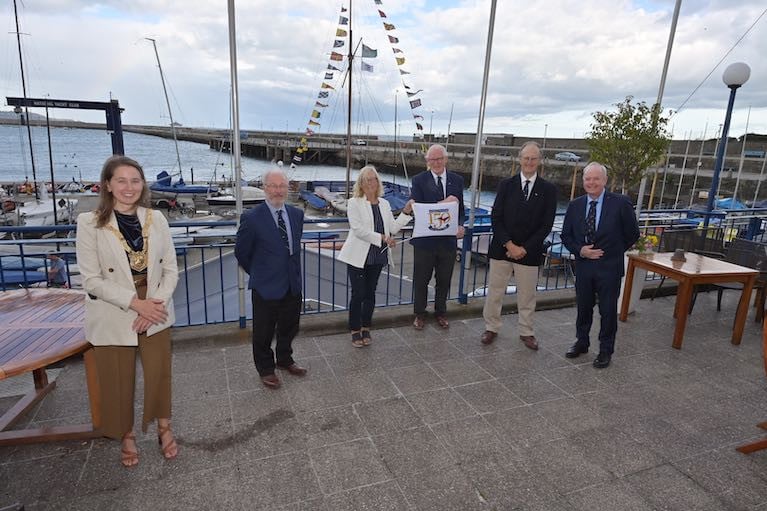Displaying items by tag: National Yacht Club
National Yacht Club's History is the Story of 150 Years of Ireland Through a Special Perspective
Most yacht and sailing clubs begin with a group of like-minded friends sailing and racing - sometimes together, sometimes against each other - until activity reaches such a level that some sort of organisation is required, and in time it's created. The classic Irish cynic will then tell you that, following the formation of a group of some sort, the second item on the agenda is almost inevitably The Split.
Be that as it may, with split or not the nascent nautical organisation may well function for some time – occasionally a very long time – before it feels the need for any premises, waterside or otherwise. And a few will actually have it written into their constitution that they won't have a clubhouse at all, in order to keep the emphasis on boats, and being on board them.
 The building in its first incarnation as the Kingstown Royal Harbour Boat Club in the 1870s. When the tide was in, the kind-hearted discerned some resemblance to a miniature Venetian palazzo
The building in its first incarnation as the Kingstown Royal Harbour Boat Club in the 1870s. When the tide was in, the kind-hearted discerned some resemblance to a miniature Venetian palazzo
But the National Yacht Club, nestling in its snug southeastern corner of Dun Laoghaire Harbour for 150 years, is noted for doing things differently. And it's an attitude which the club displayed from the get-go. On November 26th 1869 a group of seemingly solid citizens of what was then Kingstown decided to form a Boat Club in order to accommodate what they felt sure was an unfulfilled wish to go rowing.
Or at least that was the core of their proposed club. They decided the best way forward was to build a waterfront clubhouse on a site – "a plot of land" - to which they were somehow entitled. Thus on April 20th 1870, the foundation stone was laid for what was to become the very real headquarters of the Kingstown Royal Harbour Boat Club before the year was out.
 The famous "plot of land" in the 1860s, before the clubhouse was built, with the Royal St George YC already in existence beyond. When the tide was in – as here – the "plot of land" was non-existent. Photo: Mick Breen
The famous "plot of land" in the 1860s, before the clubhouse was built, with the Royal St George YC already in existence beyond. When the tide was in – as here – the "plot of land" was non-existent. Photo: Mick Breen
It was and is a pleasant Wiliam Stirling-designed building which, if viewed kindly from seaward in its original form as the water rose above half tide, looked not unlike one of the less pretentious Venetian palazzos, as the "plot of land" which the developers had so vigorously promoted as being conveniently available for a clubhouse was well under the sea at high water.
Maybe so, but the building literally rose above it. And thus while ideas are intangibles to which specific dates are sometimes only attached with difficulty, the existence or otherwise of a stone-built building it not a matter for disputation. So what we now know as the National Yacht Club has been in existence since 1870, and there is a 150th Anniversary – a Sesquicentennial no less – to be celebrated in 2020 by what is now one of the most active and inventive yacht clubs in Ireland.
In the countdown towards this significant anniversary, the erudite Donal O'Sullivan – whose services to sailing as long-time Honorary Secretary of Dublin Bay Sailing Club would have been enough "duty done" for most folk - was in the throes of producing a history of the NYC, this other club which he loves with the same passion as DBSC, of which he wrote a Centenary history back in 1984.
 Donal O'Sullivan – a keen Dun Laoghaire sailor since the 1960s, he served for many years as Honorary Secretary of Dublin Bay Sailing Club and wrote its history for its Centenary in 1984, and now he has written the history of his home club, the National YC, for its 150th Anniversary in 2020.
Donal O'Sullivan – a keen Dun Laoghaire sailor since the 1960s, he served for many years as Honorary Secretary of Dublin Bay Sailing Club and wrote its history for its Centenary in 1984, and now he has written the history of his home club, the National YC, for its 150th Anniversary in 2020.
Meanwhile, the many voluntary administrators and sailors who put so much effort into making the National what it is were upping their game under the inspired leadership of Commodores Ronan Beirne and more recently Martin McCarthy, and as 2019 drew to a close, all the signs were that while the National Yacht Club may have had slightly eccentric beginnings back in 1870, in 2020 it was going to be right in the mainstream of sailing as it celebrated a special 150th year.
But with the Pandemic tightening its grip through February and March, the likelihood of anything like the full proposed programme receded. And though Commodore McCarthy was unmistakably The Gaffer for the traditional choreographed launching of boats from the club platforms at the end of April, any indoor events were already severely curtailed.
 The Gaffer – NYC Commodore Martin McCarthy with a hands-on approach at the launching of the NYC fleet at the end of April. Photo: Afloat.ie/David O'Brien
The Gaffer – NYC Commodore Martin McCarthy with a hands-on approach at the launching of the NYC fleet at the end of April. Photo: Afloat.ie/David O'Brien
Fortunately, individual sailing could begin under eased restrictions by the end of May, junior training classes were also possible, and by early July the basic Dublin Bay SC programme was under way, albeit in a tightly supervised form. As well, a limited Irish Sea Offshore Racing Association programme was implemented under the direction of former NYC Commodore Peter Ryan, who also looked after the start and provided the Yellowbrick trackers for Irish sailing's 2020 highlight, the Fastnet 450, which was linked to the Royal Cork YC which - like the NYC – was generally frustrated in its 2020 plans, in its case for the Tricentennial Celebrations of the oldest yacht club in the world, which would have been an event - had it happened - of global significance.
 Sailing at last – racing was finally permitted in July, and Olympians Finn Lynch and Annalise Murphy - both NYC members – took the opportunity for competition with the vintage Dublin Bay Water Wags. Photo: Con Murphy
Sailing at last – racing was finally permitted in July, and Olympians Finn Lynch and Annalise Murphy - both NYC members – took the opportunity for competition with the vintage Dublin Bay Water Wags. Photo: Con Murphy
Meanwhile in the NYC, the mood was very subdued, with sailing other than junior training closed down again in mid-September with the arrival of COVID-19's Second Wave. Thus in addition to the Fastnet 450, the only way the National Yacht Club's Sesquicentennial was going to be significantly marked was through the publication of the history, which was performed last weekend through Zoom in a very socially-distanced style by Commodore McCarthy, author Donal O'Sullivan, and Councillor Una Power, Cathaoirleach of Dun Laoghaire/Rathdown County Council.
 Socially-distanced launching for the new NYC History with (left to right) Commodore Martin McCarthy, Councillor Una Power (Cathaoirleach of Dun Laoghaire/Rathdown County Council, and author Donal O'Sullivan)
Socially-distanced launching for the new NYC History with (left to right) Commodore Martin McCarthy, Councillor Una Power (Cathaoirleach of Dun Laoghaire/Rathdown County Council, and author Donal O'Sullivan)
Donal O'Sullivan has very sensibly subtitled his new book "The Chronicles of a Dun Laoghaire Yacht Club", and its production costs have been covered by Bourke Builders Ltd, a company that has Mayo origins from 1960, but is now active in the Dun Laoghaire area in so many ways that director Brian Bourke was awarded the NYC's Muglins Cup for the most interesting family cruise in 2019, a generations-shared venture to St Kilda far west of the Outer Hebrides with his Oceanis 35 Zoe B.
This fine cruise well indicates the level of multiple achievements in both racing and cruising, and in dinghies and keelboats, that the National YC membership takes in its slide in a normal year, and underlines just how hobbled we all have been in 2020.
But equally, as Zoe B's cruise reminds us of the complexity and sheer energy expended afloat – both locally, regionally, nationally and internationally in a wide variety of sailing specialities by a club of the modern NYC's calibre - we soon realise that a bald narrative of what was done, achieved and won would produce a suffocating amount of data which would confuse rather than inform.
Yet by choosing to take the Chronicles approach, the author gives himself and his readers freedom to enjoy many choice vignettes about club life and the rugged seafarers involved, without becoming swamped in endless sailing and club administration detail.
 Double-spread of the cover of new NYC history, which has been sponsored by Bourke Builders. Bottom left is Freddy Brownlee's Uffa Fox-designed Flying Fox NYC from 1953, bottom right is Annalise Murphy returning to the club with her Olympic Silver Medal in August 2016, and top right is the then-accessible roof/viewing platform of the original club.
Double-spread of the cover of new NYC history, which has been sponsored by Bourke Builders. Bottom left is Freddy Brownlee's Uffa Fox-designed Flying Fox NYC from 1953, bottom right is Annalise Murphy returning to the club with her Olympic Silver Medal in August 2016, and top right is the then-accessible roof/viewing platform of the original club.
With Dun Laoghaire Harbour's special situation of being more or less the only convenient access point to Dublin Bay sailing for the decidedly affluent population of South Dublin, much day-to-day sailing business has devolved on Dublin Bay SC, and the clubs can focus more energy on their members' immediate boat needs, junior and adult training, the requirement for full shoreside personal facilities, and an energetic and sometimes only vaguely sailing-related social programme.
Add in the fact that the three other yacht clubs - the Royal St George and the Royal Irish on the waterfront, together with the Dun Laoghaire Motor Yacht Club on the Inner Harbour - have their histories, character and functions more clearly defined, and the way is thus left for the for the National Yacht Club with its mysterious origins to pursue its own individual course with a slightly Bohemian character, a vibrant link to Dublin's over-lapping worlds of culture and creativity, and some very strong and distinct political and business connections which have given it a unique flavour.
This is the way it has turned out, but back in the 1870s things didn't look so rosy. The promoters persuaded one of the local big cheeses among the land owners, Lord Longford of the Pakenham family, to lay the foundation stone on April 20th 19870, and provided him with a very ornate and inscribed trowel to do the business. This much-embellished article, which gave added meaning to the notion of laying it on with a trowel, was provided by one of the members of the new club, Thomas Brunker, who had a jewellery shop in Grafton Street in the heart of Dublin.
The stone-laying ceremony went off with style, and the building went ahead with such quality of the basic stonework that - when added to the extra challenge of effectively building on the foreshore – the members saw the final price come in at around £4,000, about twice the original estimate, and calculated to be about €4 million today.
Thus the original promoters were financially up against it from the start, and though several of them were sailing men who could use the club as their base, Dublin Bay SC was not to come into being until 1884, the mainstay of sailing was only the Saturday afternoon racing, and so regular use of the clubhouse facilities in anything reminiscent of today's style relied on the hoped-for presence of rowing enthusiasts, who failed to materialize despite the club having a membership of around 200.
 Aerial view of the southeast corner of Dun Laoghaire Harbour at low water Springs in 1933, when it had been largely unchanged in 50 years. There was still virtually no platform space at either the National YC (left) or the RStGYC (right).
Aerial view of the southeast corner of Dun Laoghaire Harbour at low water Springs in 1933, when it had been largely unchanged in 50 years. There was still virtually no platform space at either the National YC (left) or the RStGYC (right).
By the end of the 1870s, the Kingstown Royal Harbour Boat Club was in serious financial difficulties, and in February 1881 it was put into liquidation. Among those being named as officers of the club at this time was the unfortunate Thomas Brunker, who had made the ornate silver trowel back in the glad days of 1870 for Lord Longford to lay the foundation stone.
However, in September 1879 the building in Dublin with Thomas's shop centred in it collapsed into Grafton Street, which wasn't good for business, and then in February 1881, his beloved club in Kingstown collapsed into liquidation. Donal O'Sullivan recounts all this in a certain deadpan yet droll style, such that only a heart of stone could resist the impulse to mirth. But sad and all as the Brunker fate was, it gives us an insight into how the life of the club was intertwined with the middle class social and sporting life of Kingstown and Dublin Bay, and the business and commercial life of Dublin, a theme which is fascinatingly evident throughout the book.
For although the first iteration of a club may have evaporated, the multi-use prime location building was still very much in existence.
It was sold at a knockdown price of £1250 to "a syndicate of gentlemen thoroughly interested in the progress of Kingstown." But they were equally interested in their own financial safeguards, so the new organization they brought into being to run the club was finalized in 1883 as the Kingstown Harbour Yacht Club Ltd., though for sailing purposes the "Ltd" somehow managed to disappear, a necessary step as the club had become more active in organizing sailing races.
Quite what the quality in the Royal St George YC and the Royal Irish YC made of these goings-on just along the waterfront we can all too easily guess, and it wasn't improved by some of the goings-on of the KHYC members among themselves, with two of them ending up in the Exchequer Court in 1884 over the running costs of a yacht they jointly owned. And soon the KHYC itself was no stranger to the Four Courts, for on 8th March 1887 the Master of the Rolls gave an order for the club to be wound up, and by the end of the month the building was for sale for the second time in its short life of 17 year, the attractive William Stirling-designed clubhouse surely a golden opportunity if only the right person was interested.
Cometh the hour, cometh the man…..Charles Barrington (1834-1901) was an astonishing achiever in almost every interest he took up. He was very much of Ireland's "energetic and industrious Quaker type", being one of the Barringtons of Fassaroe in North Wicklow, and married to another industrious Quaker, one of the Grubbs of Tipperary. There doesn't seem to be any family connection to the contemporary Barringtons who now play such a leading role in Dun Laoghaire and Irish sailing, but back in the late 1880s, CB - as everyone seems to have known him – was definitely The Man.
 Charles Barrington (1834-1901) is now largely unknown, yet he was quite the man in late 19th Century Dublin. In 1858, although largely untrained in mountaineering, he made the first ascent of the Eiger during his only visit to Switzerland. In 1870 he won the first Irish Grand National, anonymously riding a horse he'd trained himself. And in 1887 he bought the building which is now the National Yacht Club, and made it into a popular commercial success for hospitality as the Absolute Club, while improving its qualities as a yacht and sailing club
Charles Barrington (1834-1901) is now largely unknown, yet he was quite the man in late 19th Century Dublin. In 1858, although largely untrained in mountaineering, he made the first ascent of the Eiger during his only visit to Switzerland. In 1870 he won the first Irish Grand National, anonymously riding a horse he'd trained himself. And in 1887 he bought the building which is now the National Yacht Club, and made it into a popular commercial success for hospitality as the Absolute Club, while improving its qualities as a yacht and sailing club
He was the first to climb the Eiger during his only trip to Switzerland in 1858, a feat properly praised by the great Heinrich Harar, he also won the first Irish Grand National in 1870 on a horse he trained himself, riding as jockey under an assumed name as involvement in a sport involving gambling would have offered his co-religionists. And by the 1880s he was so much into sailing – well supported by the family soap business which merits a mention in Ulysses – that he had two substantial sailing yachts in Kingstown Harbour, the larger a 77ft schooner called Avalanche, which may have been a nod towards the fact that, while descending from his insouciant conquest of the Eiger in 1858, he and his team were almost swept away into oblivion by an avalanche.
He also had a couple of curious hobby businesses: two gentlemen's clubs – the Ormond and the Sheridan - in Dublin's clubland near Stephen's Green. We'll resist the temptation to draw any analogies between a noted contemporary Dublin Bay sailor who is also a renowned innovator in the very different 21st Century clubland scene in the city, but the fact is that on 12th July 1887 Charles Barrington snapped up the empty KHYC premises for £1300, promptly renamed it the Absolute Club, turned it into a hospitable place with women visitors made particularly welcome, and somehow managed to retain the sailing club ethos while making it all a bit of fun – with frequent special events – all of which turned a modest but essential profit.
Who knows, but as Ireland's yacht and sailing clubs in due course emerge from the ill-effects of the pandemic, in order to fulfil their true potential and continuing existence we should maybe look a bit more realistically at the Barrington approach, and see how commercial viability, a friendly atmosphere and shared enthusiasm can provide the environment in which sailing can prosper and be enjoyed.
 Charles Barrington would have approved…..party time for all at the National Yacht Club.
Charles Barrington would have approved…..party time for all at the National Yacht Club.
By the time Barrington died in 1901, it's arguable that the unique atmosphere which still pervades the National Yacht Club had been firmly put in place thanks to his benevolent and energetic presence. Subsequently, the club has been through two further name changes, it has survived at least eight fires - two of them major ones - it has seen its lower floors – originally the KHBC boathouse – flooded out completely, and it has come through some very good times economically when it expanded its facilities, but like everyone else it has also had to hang in by the finger-nails through various setbacks to the world economy.
Then, of course, there was the time it served as the new Free State Government Reception Area in the 1920s, when delicate negotiations between the Cosgrave government in Dublin and the London government required a private suite of rooms convenient to the Mailboat Pier in Dun Laoghaire, and the Edward Yacht Club - as it had been since Barrington's death - readily obliged.
It was an arrangement which was never officially minuted, yet everyone in a "need to know" situation was fully aware of it. Thus it was that when, in 1931, the noted international yachtsman the Earl of Granard (instigator of the One Ton Cup) willingly agreed to be Commodore of the club when it was re-named the National Yacht Club, (after he'd surprised many by emerging some years before as a Catholic Nationalist), he hosted an extraordinary reception in the club attended by just about all of the Great and the Good of the new Ireland, including some who less than ten years earlier might have quite cheerfully assassinated each other.
 The Man Who Surprised Everyone. He may have been best known on the world sailing scene as the man who donated the One Ton Cup for international competition in 1899, and in Ireland he was best known as Commodore of the North Shannon Yacht Club. But when Bernard Arthur Patrick Hastings Forbes, 8th Earl of Granard KP, GCVO (1874-1948) became first Commodore of the re-constituted National Yacht Club in Dun Laoghaire in 1931, it emerged he was a Catholic Nationalist whose inauguration ceremony in the NYC was attended by many powerful figures in the new Irish Free State.
The Man Who Surprised Everyone. He may have been best known on the world sailing scene as the man who donated the One Ton Cup for international competition in 1899, and in Ireland he was best known as Commodore of the North Shannon Yacht Club. But when Bernard Arthur Patrick Hastings Forbes, 8th Earl of Granard KP, GCVO (1874-1948) became first Commodore of the re-constituted National Yacht Club in Dun Laoghaire in 1931, it emerged he was a Catholic Nationalist whose inauguration ceremony in the NYC was attended by many powerful figures in the new Irish Free State.
Despite this gala launching, things were quiet enough for the club in the humdrum economic realities of the 1930s, but new names such as designer/builder John B Kearney and his close friends became a distinct focus group, and in the early '30s the Mermaid class from his design began to emerge, a useful general-purpose 17-footer which by the 1950s had become the biggest class in Dun Laoghaire.
 Noted skipper and designer John B Kearney was a leading figure in the National YC in the 1930s, 40s 50s and 60s.
Noted skipper and designer John B Kearney was a leading figure in the National YC in the 1930s, 40s 50s and 60s.
The advent of more modern dinghies after 1945 swept through the National YC as it swept through other clubs, and over the years the quaint "Venetian palazzo with an Irish accent" began to disappear behind new slipways and boat platforms to accommodate classes as diverse as the 505s and the Optimists, with the NYC leading the way in introducing Ireland to the latter kids boat, thanks to Johnny Hooper, Carmel Winkelmann and Paddy Kirwan.
 The basic structure of the clubhouse was still largely unchanged in the early 1960s…
The basic structure of the clubhouse was still largely unchanged in the early 1960s…
 …..and as the club led the way in adopting the Optimist for Junior Training, launching facilities were initially very primitive.
…..and as the club led the way in adopting the Optimist for Junior Training, launching facilities were initially very primitive.
In addition to interesting cruisers such as Freddy Brownlee's Uffa Fox-designed-and-built Flying 35 Flying Fox, by 1960 the NYC were into the Olympics with an Olympic Race win for Johnny Hooper and Peter Gray in the Flying Dutchman in Rome in 1960.
And when boats like the 505 proved too expensive, the NYC were among the leaders in the move into more economical Fireball, a move made to such good effect that in 1995 John Lavery and David O'Brien of the NYC won the Fireball Worlds staged by the NYC.
 John Lavery and David O'Brien on their way to winning the 1995 International Fireball Worlds at the National Yacht Club for the National Yacht Club.
John Lavery and David O'Brien on their way to winning the 1995 International Fireball Worlds at the National Yacht Club for the National Yacht Club.
Offshore, the National YC has always played a leading role in ISORA, and in the Round Ireland race its skippers – particularly Eamonn Crosbie – having left a lasting mark of success, while the club's own user-friendly Dun Laoghaire to Dingle race – inaugurated by Martin Crotty and Peter Cullen on a biennial basis in 1993 is a hugely popular event.
Perhaps there's an enduring legacy from the time of Charles Barring in the fact that women members have always been in leading roles afloat and ashore, with the first Woman Commodore being Idea Kiernan in 2000-2002, and that after she'd made a major contribution to developing Irish sailing through running the Dun Laoghaire Sailing School for many years.
 Ida Kiernan was first female Commodore of the National YC in 2000-2002, and was a training pioneer with the foundation of the Dun Laoghaire Sailing School.
Ida Kiernan was first female Commodore of the National YC in 2000-2002, and was a training pioneer with the foundation of the Dun Laoghaire Sailing School.
We get an idea of the breadth and depth of the National Yacht Club's basic strength and vitality in realizing that it has been the Mitsubishi Motors Sailing Club of the Year five times, in 1981, 1985, 1996, 2012 and 2018 - a very significant score.
The National YC achieves this through being its own friendly self while aspiring to the highest levels of achievement. A long time ago, the recently-widowed Mrs Mac Aleavey had a daughter who was keen to sail. and had been given the present of a 420. But the small family were relatively new to Dublin, and hadn't been able to find a club with the facilities and friendliness which the young tyro sailor hoped for.
Then they tapped on the front door of the last club along the Dun Laoghaire waterfront, and were immediately made at home. In 1988, the daughter Cathy represented Ireland in the 470 in the Olympics Then in 1993, she and her husband Con Murphy (whom she'd introduced to sailing and who went on to be a National YC Commodore) brought Steve Fossett's 60ft trimaran Lakota to Ireland, and – sailing from the National – established a round Ireland Record which stood for 22 years.
 Con Murphy and Cathy Mac Aleavey at the party in the National YC to celebrate their new round Ireland record in 1993.
Con Murphy and Cathy Mac Aleavey at the party in the National YC to celebrate their new round Ireland record in 1993.
Then in 2016 their daughter Annalise returned to the greatest welcome home reception ever seen at an Irish yacht club. It was, of course, the National YC, and she'd won the silver medal at the Rio Olympics.
There's all this and much much more in Donal O'Sullivan's well-illustrated The National – Chronicles of a Dun Laoghaire Yacht Club. It's utterly absorbing, the variety of the stories and the characters of the main players are remarkable, and yet it's of that ever-to-be-blessed size which can be comfortably read in bed. Its pure lockdown luxury and you can get it for €15 or €20 posted.
Global sailing's focus of attention this week is on Bermuda, where the 70th Annual Bermuda Gold Cup and 2020 Open Match Racing World Championship is underway with GBR's Ian Williams the defending title-holder against fifteen other top drivers, Williams having won the 2019 final from Sweden's Johnie Berntsson.
Those who followed the 2019 Gold Cup may not recall it as having quite the same razzmatazz as the current event. But that's because, thanks to the international pandemic shutdown, Bermuda's position of natural isolation as a sunny little mid-ocean archipelago has enabled it to achieve an acceptable level of quarantine. Thus as the other national events in the World Match Racing Series were forced to cancel, the canny Bermudans worked carefully to having everything in place to make their end-of-October event the only show in town.
Thus they've taken aboard generous sponsorship from the Bermudan Tourism authorities, which would otherwise be having a very thin year, and for good measure they've beefed out the title to make it the 2020 Open Match Racing World Championship while they're at it, for who's to argue?
 The National YC's flagship in San Diego. Johnny Smullen's classically-restored International One Design Altair slipping effortlessly along in Californian waters
The National YC's flagship in San Diego. Johnny Smullen's classically-restored International One Design Altair slipping effortlessly along in Californian waters
Yet although for such an event you might expected very special boats – maybe even the pace-setting Mark Mills-designed ILC Melges 37 – they're sticking with the tried and trusted GRP versions of the 33ft 1936-designed International One Design, which was originally commissioned by American sailing legend Cornelius Shields from Norwegian designer and builder Bjarne Aas of Fredrikstad south of Oslo.
Johnny Smullen
Between them, they created a classic which caught on in many places including Bermuda, and it was very much the premier One Design keelboat fleet there when the Gold Cup for match-racing was inaugurated in 1950. Over the years, they may have introduced a GRP version, but basically, the top match-racing stars are still sailing a boat which manoeuvres slowly but certainly, and is well-behaved in every way while providing a miniature version of America's Cup racing when it was sailed in 12 Metres, which many would reckon were the golden years of that particular stellar-fest.
As we write, the Gold Cup 2020 is going full blast on Hamilton Harbour, Bermuda, with the numbers gradually being whittled down towards the weekend's final. But meanwhile, it's timely to recall a real if extended link to the National Yacht Club in Dun Laoghaire, ancestral club of Johnny Smullen, master shipwright and the man-to-go-to around boats in San Diego in California.
When America's Cup legend Dennis Conner was at the most active stage of his classic boat passion, Johnny Smullen was his personal shipwright and boat-restorer. But Johnny meanwhile had his own enthusiasms, and one of them was for the classic wooden-built International One Design. He secured one of them, Altair, and restored her to better-than-new condition, such that she is now one of the ornaments of San Diego Harbour, sailed and raced with a reverence and respect which is a whole world away from the rough and tumble of the Gold Cup in Bermuda.
 A boat which looks good from any angle – a very contented Johnny Smullen at the helm of his IOD Altair
A boat which looks good from any angle – a very contented Johnny Smullen at the helm of his IOD Altair
Cork Harbour linkage
And if you would seek a Cork Harbour link to the current Bermuda contest, cast your mind back to the International 8 Metre If, brought originally to Cork Harbour by Aylmer Hall, and then owned for many years - after Hall had bought the 12 Metre Flica – by Tom Crosbie. If was not only a classic Bjarn Aas design and build in the IOD style, but her role as Altair's big sister was further reinforced by her topsides being painted the same discerning shade of blue.
 Let's hear it for Cork Harbour. Tom Crosbie's International 8 Metre If, making smooth progress off the Cobh waterfront in the early 1960s, is very much Altair's big sister. Photo: Pascal Roce
Let's hear it for Cork Harbour. Tom Crosbie's International 8 Metre If, making smooth progress off the Cobh waterfront in the early 1960s, is very much Altair's big sister. Photo: Pascal Roce
National Yacht Club Winter Lift Out of Sailing Cruisers Completed
After a delay due to a doubtful weather forecast for Saturday, the National Yacht Club's annual winter lift-out of cruisers was completed on Sunday in near perfect conditions. The day-long operation sees a mobile crane with an extended jib visit the club to lift the boats from Dun Laoghaire Harbour with some precision.
As regular Afloat readers will recall, the NYC lift in for the COVID shortened season eventually happened as late as May 31st, thus giving the NYC sailors a season of almost five months on the water despite all the problems associated with season 2020.
It completes a weekend of lift outs at the south Dublin Harbour with the neighbouring Royal St. George boats coming out on Saturday, also in fine conditions despite forecasts to the contrary.
While the bulk of the NYC fleet is now hauled out and ashore on the club's hard standing some club boats are still afloat at the marina awaiting news of the postponed DBSC Turkey Shoot where the hope is that there may still be some pre-Christmas racing after Level 5 COVID restrictions are lifted.
National Yacht Club Pays Tribute to Former Manager Tim O'Brien
National Yacht Club flag officers have presented former manager Tim O'Brien with a 3-D map of Dublin Bay as a thank you for the contribution he made to the East Pier Club in Dun Laoghaire Harbour.
Commodore Martin McCarthy made the socially distanced presentation as a token of member's appreciation for Tim's ten years of service.
During his tenure, the club was awarded the Mistubishi Irish Sailing Club of the Year award in 2018.
As Afloat reported recently, a new general manager is now on the helm at the NYC.
ICRA Moves 2021 Cruiser Racer National Championships Out From May to September
After cancelling its 2020 championships twice, the Irish Cruiser Racing Association (ICRA) has now seen fit to move the dates of its 2021 National Championships from May to September next year because of the continuing threat of COVID-19.
In a statement issued this afternoon, Commodore Richard Colwell, said "It is now evident that the continued impact of Covid-19 will be felt well into 2021. With that in mind, ICRA was conscious of a need to provide as much time as possible to try and ensure that a National Championship does take place in 2021".
As such, ICRA says it has worked with Dun Laoghaire Harbour's National Yacht Club, the 2021 hosts of the event, to rearrange the National Championship dates from its original date in late May, to an alternative date in early September 2021.
The change also removes an unfortunate clash with the Scottish Series that occurred with the former date, as Afloat reported here.
The new dates for next year's ICRA National Championships are September 3rd - 5th 2021.
In 2020, it was originally planned to race the ICRA Nationals as part of Cork Week and RCYC's 300th celebrations and when that July date was cancelled, ICRA opted to race as part of Septembers' rescheduled Wave Regatta which in turn was axed at Howth also due to COVID leaving the championships not sailed for the first time in its 18-year-history.
National Yacht Club to Run Under 25-Match Racing Event This Weekend
The National Yacht Club at Dun Laoghaire Harbour is set to run the first of their 'Covid Friendly' match racing events this weekend. Eight Under 25 teams will battle it out in the club's fleet of four Elliott Six-Metre sportsboats.
As the first event of its kind, the aim is to increase the interest and involvement of youth sailors in match racing.
The NYC Match Racing scene kicked off last October after the club purchased the sportsboats.
The racing format will consist of two sessions, morning and afternoon with finals in the evening. Each session will have four teams of three sailors each that are counted as their own pod.
 Match Racing in the Elliott Six-Metres off Dun Laoghaire
Match Racing in the Elliott Six-Metres off Dun Laoghaire
The top two teams from each session will progress to the finals. Teams will race in four boats to avoid changeovers and maintain social distancing.
The boats will also be sanitised before each session. It is great to see such activity happening in the club throughout COVID-19, and every precaution is being taken to ensure the event remains compliant.
The event follows on from the NYC150 Regatta last week that attracted a record turnout on Dublin Bay this season.
Tight Racing for Flying Fifteens at National Yacht Club 150th Race Day
For a Class that has been synonymous with the National Yacht Club, for a significant period of time, – there are seventeen Flying Fifteens parked on the deck – it was entirely appropriate that there should be a good turnout for the celebration of the 150th Anniversary of the Club. Thirteen boats from the host club were joined by two from the DMYC and one from the RStGYC for the three-race event on Saturday past.
XCWeather was forecasting 12- 15 knots with gusts in the 18/19 range and that was an accurate assessment of what was enjoyed on the water. Wind direction was slightly north of west and that wasn't too far of the mark either.
International Race Officer Con Murphy and his team were able to give his charges – SB20s, Sportsboats, Dragons, Fifteens, Ruffians and Shipmans a good-length beat with two laps for each race.
The consensus view as to go left off the first start line towards the shore and by halfway up the beat it was apparent that Ian Mathews and Keith Poole (3864, The Gruffalo) were going to be the boat to catch. By the rounding of the first weather mark they had a comfortable lead and could watch the peloton chasing them with some comfort. The peloton consisted of John Lavery & Alan Green (4803, Phoenix), Neil Colin & Margaret Casey (4028, Ffuzzy), Ben Mulligan & Cormac Bradley (4801, Enfant de Marie), and Alistair Court & Conor O'Leary (3753, Ffinnisterre). While Mathews & Poole were undisturbed after the first weather mark, Lavery, Colin and Mulligan found themselves in reasonably close company for the balance of the race, before finishing in the order, Lavery, Colin, Mulligan, Court, behind Mathews.
Mulligan & Bradley led the second race to the first weather mark and enjoyed the same position down the first downwind leg. However, Lavery & Green were lurking and towards the last third of the second beat, they took the lead and applied a loose cover on Mulligan to the second weather mark. Behind these two Colin & Casey were having an excellent day sitting in third place with Niall Meagher & Nicki Mathews (3938, The Ffantastic Mr Fox) appearing well up the pecking order. Tom Murphy & Karl (4057, Fflagella) were also part of the peloton chasing the lead pair. Mathews & Poole were conspicuous by their absence and they would eventually finish in 9th place. Ahead of them, the finishing order was Lavery, Mulligan, Colin, Meagher and Murphy.
For the final race of the day, Mathews & Poole got the "bit between their teeth" to quote my helm and repeated the performance of the first race, storming into a first-leg lead that they never relinquished. Colin & Casey were also well up the order in a podium place, enjoying the fresh conditions. Murphy too had an excellent star and first beat to establish a place at the head of the fleet. Lavery found himself having to chase the lead boats to get into the race and he and Mulligan joined the bunch chasing Mathews. Throughout the race, the two new boats were either crossing tacks or watching each other down the offwind legs and in the second run down to the leeward mark a poor gybe by Bradley saw Lavery park his bow very close to Mulligan's transom. This was enough to give Lavery an incentive to chase Mulligan into the finish-line upwind of the committee boat and with the boats overlapped on the finish line, Lavery got the nod to finish fourth, behind Mathews, Colin and Murphy.
With no formal prize-giving for the day, the DMYC boats, Colin and Mulligan headed westwards and tried to work out the overall results for the day – the debate being – Was a discard applicable or not? The first iteration of an overall result had an incorrect result for Lavery and a discard applying. That gave the regatta win to Mathews & Poole (1, 1) versus 1,4 for Lavery, 2,3 for Colin and 2,4 for Mulligan.
Then the correction was applied to Lavery's first race result giving him back his second place. With a discard applying Mathews was still in pole position, but Lavery jumped to second, with Colin down to third.
But if all races were to count, the result changed again with Lavery taking pole position (2, 1, 4), Colin second (3,3,2), Mathews third (1,9,1) and Mulligan fourth (4,2,5).
It appears the NoR may have specified the discard rule for "less than three races" and "more than three races", but not for the actual three races sailed.
But for the purposes of this report the results (of the races) are;
- John Lavery & Alan Green, NYC; 4083, Phoenix: 2, 1, 4
- Neil Colin & Margaret Casey, DMYC; 4028, Ffuzzy: 3, 3, 2
- Ian Mathews & Keith Poole, NYC; 3864, The Gruffalo: 1, 9, 1
- Ben Mulligan & Cormac Bradley, DMYC; 4081, Enfant de Marie: 4, 2, 5
- Tom Murphy & Karl, NYC: 4057, Fflagella: 9, 5, 3
IRO Con Murphy gave us an excellent day's racing and post the event many people noted how physical the day had been – but in a very pleasurable way!
Butler Retains Leinster Fireball Trophy in NYC 150th Event at Dun Laoghaire Harbour
It was a lively day of racing for Fireballs during the NYC 150th Race Day today at Dun Laoghaire Harbour. While the class was dismayed to hear that racing would be confined to the harbour the wind gods smiled on the fleet and sailors enjoyed westerly winds between 12 and 24 knots.
In race one, Frank Miller/Ed Butler led to the weather mark but a sudden vacuum of air at the mark caused a significant teabagging ceremony which allowed Noel Butler with crew Neil Cramer fly past into a lead which they never relinquished. Miller/Butler shook themselves down and gave chase, with Louise McKenna/Hermine O'Keeffe hot on their heels. The latter overtook downwind but were reeled in again when Miller/Butler gybed and regained inside overlap before the leeward mark. In race two, Butler/Cramer got clean away at the start and were never challenged. Miller/Butler had a disastrous start and spent the entire race recovering. Owen Sinnott and Grattan Donnelly sailed an excellent race, especially upwind where they perfectly judged the shifts and variations in pressure to stretch their lead on the chasing pack and were rewarded with a second place. In race three Butler/Cramer again got away from the pack with Miller/Butler closest behind. With the wind up a notch that pair pulled away from the followers to score 2nd, followed by McKenna/O'Keeffe, Sinnott/Donnelly.
Three wins (one to discard) gave Butler/Cramer the overall event with Miller/Butler second and Sinnott/Donnelly 3rd. Mention should be made of those relatively new to Fireballs who took part in fresh and exciting conditions and lived to tell the tale including Paul Ter Host and Colm Breen from SID and young Clodagh Fischer with her father Glen on the wire.
As the class had designated this event as it's Leinsters Butler got to keep the trophy which carried along in his sailing bag. All in all a great day's racing and thanks are due to the NYC, the organisers, race committee and rescue volunteers who made it possible.
National Yacht Club 150th & DBSC Saturday Race Results
Today's National Yacht Club 150th anniversary regatta saw a large fleet of 152 dinghies and keelboats complete a full programme of races for NYC Sesquicentennial medals.
Raced in moderate to fresh North Westerly breezes, up to three races were sailed in some of the 22 competing classes that was managed on the water by Dublin Bay Sailing Club (DBSC).
Prima Forte from the Royal Irish Yacht Club was the Cruisers Zero winner on IRC and the NYC's own Gringo was the Class One winner.
Chimaera won the J109 division and the NYC entry Prospect was the 31.7 winner.
As Afloat reported earlier, last night a small but important ceremony was held at the NYC where waterfront Commodores gathered to receive special NYC burgees as a token of appreciation for the support in staging today's special event.
Full results are below
DBSC Results for 05/09/2020
Race 1
Cruiser 0 IRC: 1. Prima Forte, 2. Wow, 3. D-Tox
Cruiser 0 Echo: 1. Prima Forte, 2. Wow, 3. D-Tox
Cruiser 1 IRC: 1. Gringo, 2. Chimaera, 3. Joker 2
Cruiser 1 Echo: 1. Joker 2, 2. Gringo, 3. Chimaera
Cruiser 1 J109: 1. Chimaera, 2. Joker 2, 3. Jalapeno
31.7 One Design: 1. Prospect, 2. Levante, 3. Attitude
31.7 Echo: 1. Attitude, 2. Levante, 3. Fiddly Bits
Cruiser 2 IRC: 1. Windjammer, 2. Rupert, 3. Peridot
Cruiser 2 Echo: 1. Rupert, 2. Enchantress, 3. Springer
Cruiser 2 Sigma 33: 1. Rupert, 2. Springer, 3. Enchantress
Cruiser 3 IRC: 1. Dubious, 2. Starlet, 3. Eleint
Cruiser 3 Echo: 1. Papytoo, 2. Pamafe, 3=. Dubious, 3=. Eleint
Cruiser 5 NS-IRC: 1. Gung Ho, 2. The Great Escape, 3. Act Two
Cruiser 5 Echo: 1. Sweet Martini, 2. Spirit, 3. Katienua
SB20: 1. Ted, 2. Sneaky B, 3. Carpe Diem
Sportsboat: 1. Jamiroquai
Dragon: 1. Phantom, 2. D-Cision
Flying 15: 1. The Gruffalo, 2. 4083 (JL), 3. FFuZZy
Ruffian: 1. Bandit, 2. Ripples, 3. Ruffles
Shipman: 1. Viking, 2. Jo Slim, 3. The Den
B211 One Design: 1. Chinook, 2. Plan B, 3. Billy Whizz
Glen: 1. Glen Luce, 2. GlenDun
PY Class: 1. R Tate, 2. B Foley, 3. S Dwyer
IDRA 14: 1. Dart, 2. Diane
Fireball: 1. F Miller, 2. O Sinnott, 3. P ter Horst
Laser Standard: 1. G Murphy, 2. R Wallace, 3. F Walker
Laser Radial: 1. H O'Connor, 2. S Craig, 3. R Geraghty-McDonnell
Laser 4.7: 1. F McDonnell, 2. L Turvey, 3. A Daly
Race 2
SB20: 1. Ted, 2. So Blue, 3. Carpe Diem
Sportsboat: 1. Jamiroquai
Dragon: 1. Phantom, 2. D-Cision
Flying 15: 1. 4083 (JL), 2. Enfant de Marie, 3. FFuZZy
B211 One Design: 1. Yikes, 2. Chinook, 3. Billy Whizz
B211 Echo: 1. Beeswing, 2. Billy Whizz, 3. Ventuno
PY Class: 1. M Gavin, 2. B Foley, 3. R Tate
IDRA 14: 1. Dart, 2. Diane
Fireball: 1. O Sinnott, 2. F Miller, 3. P ter Horst
Laser Standard: 1. F Walker, 2. R Wallace, 3. T Lyttle
Laser Radial: 1. R Geraghty-McDonnell, 2. S Craig, 3. C Gorman
Laser 4.7: 1. H Turvey, 2. A Daly, 3. F McDonnell
Race 3
PY Class: 1. B Foley, 2. R Tate, 3. S Dwyer
IDRA 14: 1. Diane, 2. Dart
Fireball: 1. O Sinnott, 2. F Miller, 3. P ter Horst
Laser Standard: 1. R Wallace, 2. F Walker, 3. C Arrowsmith
Laser Radial: 1. R Geraghty-McDonnell, 2. S Craig, 3. J O'Driscoll
Laser 4.7: 1. L Turvey, 2. F McDonnell, 3. A Daly
National Yacht Club Commodore Thanks Dun Laoghaire Harbour Clubs For Support of Sesquicentennial Race Day
National Yacht Club Commodore Martin McCarthy yesterday presented a special flag to each of four neighbouring Clubs as a mark of Solidarity and to thank them for helping his Club hold a Raceday to celebrate the Club's 150th anniversary.
Commodore McCarthy said, before a socially distanced, outdoor, audience, led by Dun Laoghaire Rathdown Cathaoirleach Cllr. Una Power: "We are marking the formal announcement of the National Yacht Club's Sesquicentennial Raceday which is the sailing highlight of this historic year for our Club. In a typical year, we would have a four-day Regatta with lots of parties and fireworks. It would have been one of the four Regattas hosted here in Dun Laoghaire – one by each of the waterfront Clubs.
Last May, it became clear that with Covid 19, everything has changed in the world – and the Sailing world.
 DBSC Race Officer Eddie Totterdell (right) accepts 150th Raceday Flag from NYC's Martin McCarthy as Cllr. Una Power officiates Photo; Michael Chester
DBSC Race Officer Eddie Totterdell (right) accepts 150th Raceday Flag from NYC's Martin McCarthy as Cllr. Una Power officiates Photo; Michael Chester
 National YC Commodore Martin McCarthy presents 150th Raceday Flag to DMYC Commodore Frank Guilfoyle with DLR CoCo Caothaoirleach in attendance Photo; Michael Chester
National YC Commodore Martin McCarthy presents 150th Raceday Flag to DMYC Commodore Frank Guilfoyle with DLR CoCo Caothaoirleach in attendance Photo; Michael Chester
An idea came from the Royal St. George YC to have a single event, to be called the Solidarity Regatta, run by all the Clubs together. As time went on, it became clear that the problem with events were not the events themselves – but the post-event social side. So, it was whittled down to a one-day event – without a social side – and now termed a RACEDAY.
 NYC Commodore Martin McCarthy presents 150th Flag to RSGYC Commodore Peter Bowring with DLR CoCo Caothaoirleach Una Power attending Photo: Michael Chester
NYC Commodore Martin McCarthy presents 150th Flag to RSGYC Commodore Peter Bowring with DLR CoCo Caothaoirleach Una Power attending Photo: Michael Chester
In a splendid gesture of Solidarity, our neighbouring Clubs allowed us to proceed with this event, renamed The NYC 150th Raceday, forgoing their Regattas.
Words cannot express how grateful we are to the other clubs, not just giving us the window to have a celebration of our 150th on the water – but for enthusiastically supporting it.
 NYC Commodore Martin McCarthy presents 150th RACEDAY flag to RIYC Commodore Pat Shannon with DLR CoCo Caothaoirleach Una Power
NYC Commodore Martin McCarthy presents 150th RACEDAY flag to RIYC Commodore Pat Shannon with DLR CoCo Caothaoirleach Una Power
In that context, we have a special commemorative Flag designed and made to mark this occasion.
We presented a National YC 150th Flag to:
- Frank Gilfoyle, Commodore of Dun Laoghaire Motor Yacht Club
- Pat Shannon, Commodore of Royal Irish Yacht Club
- Peter Bowring, Commodore of the Royal St. George Yacht Club
- Ann Kirwan, Vice Commodore of Dublin Bay Sailing Club
I also want to thank the Race Officers for the event, Eddie Totterdell & Con Murphy and the DBSC team, who has done trojan work in drawing up the plans for the Raceday. We expect to have 175 entries, from across the waterfront.
I especially want to thank Dun Laoghaire Rathdown CoCo Caothaoirleach, Una Power for being here today to mark this historic occasion.
The Council's support has been invaluable, and we much appreciate it, as we are planning now for the impacts of Covid 19, which, while temporary, is serious and maybe around for some time."
Cathaoirleach Power said: "This is an especially significant year for the National YC, which was founded, on this spot 150 years ago. The Clubs have shown great Solidarity to make the Raceday possible, and it is this spirit that we will need to show to help our tourism economy make a full recovery. Sailing is a significant employer, and we hope that we can get back to seeing more big sailing events in the future."


























